You are made to move.
Photo by Wesley Tingey
We move through our motor system which controls our strength, our ability to exert the force needed to push, pull or lift, our coordination and our ability to walk, dance, jump and swim.
First, the movement process starts with an unconscious command coming from your brain. For example, a fleeting thought, a conscious activity or a sense that something is wrong. Interpretation of your thought, for example, "I need to jump away from the falling object," triggers a coordinated, instinctual movement that is typically hard-wired at an early stage of life.
Next, our neurons (or motor neurons) carry signals from your brain through the peripheral nerves. Your nerves then send signals to your skeletal muscles, your heart, your lungs or your glands (for example sweat glands).
Your Neural Network And Your Motor System
Your brain and spinal cord are connected to your nerves, which are connected to your muscles. Usually, the movement circuit works seamlessly. However, when any point on the path from your brain to your muscles is disrupted, problems with your motor function such as weakness, incoordination and walking difficulty can occur.
Also, medical problems like blood electrolyte imbalances, drugs or toxins which affect the way your muscles work, aging and the lack of movement or motor activity.

Walking allows us to move through our environment. Locomotion involves walking, which is the most commonly used form of movement in humans. Normal walking involves your ability to balance coordination in your muscles, which then allows your body to move forward in a rhythm or stride.
Difficulty walking is related to health problems such as:
- Brain injury
- Multiple sclerosis
- Stroke
- Arthritis in the hips knee ankle or feet
- Nerve damage (neuropathy).
Let's move! Learn more about your motor system with the articles below.





